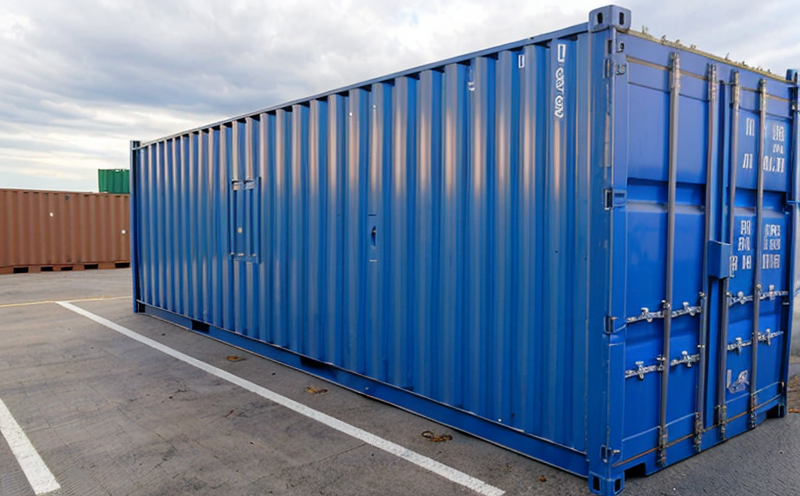ISO 4593 Thickness Measurement Testing of Plastic Storage Plastics
The ISO 4593 standard specifies a method for determining the thickness of plastic films and sheets, which is critical for ensuring uniformity and reliability in storage container design. This test is particularly important for quality managers and compliance officers who need to ensure that their plastic containers meet strict specifications.
Thickness measurement is fundamental to the integrity of any plastic storage container. Variations in thickness can lead to structural weaknesses, compromised durability, and potential safety hazards. The ISO 4593 method ensures accurate and repeatable results, which are essential for quality assurance and product consistency.
The testing process involves precise measurement techniques that allow for the evaluation of thickness at multiple points across a sample. This is crucial because plastic materials can exhibit variations in thickness due to manufacturing processes or material properties. By measuring at various locations, we can ensure that any discrepancies are identified early in the production cycle.
The standard outlines specific procedures and equipment requirements to achieve consistent results. The chosen instrument must be calibrated according to ISO standards to ensure accuracy. Specimen preparation is also critical; the sample should be cut from a representative area of the plastic sheet or film, ensuring that it reflects the thickness variation within the intended application.
Once the specimen is prepared and calibrated, measurements are taken using a micrometer or other appropriate measuring device. The standard specifies the number of points to measure for an accurate average thickness determination. This ensures that any anomalies can be detected, allowing for adjustments in the manufacturing process if necessary.
The results from this test provide vital information about the plastic container's structural integrity and performance under various conditions. For quality managers and compliance officers, these results are indispensable for ensuring product consistency and meeting regulatory requirements. R&D engineers can use this data to optimize material selection and processing techniques, while procurement teams can rely on these tests to verify supplier compliance.
- Calibration Accuracy: Ensures that the measuring device is accurate and reliable, preventing errors in thickness measurement.
- Representative Specimen Preparation: Guarantees that the sample accurately reflects the material's properties, leading to precise measurements.
- Average Thickness Determination: Provides a comprehensive understanding of the plastic container's uniformity, highlighting any potential issues early in the production cycle.
Applied Standards
The ISO 4593 standard is widely recognized and utilized across various industries for thickness measurement of plastic films and sheets. This ensures that testing is consistent and reliable, meeting international standards.
The standard specifies the use of appropriate measuring instruments such as micrometers or calipers, which must be calibrated according to ISO guidelines. The specimen preparation process involves cutting a representative sample from the plastic sheet or film, ensuring it reflects the thickness variation within the intended application.
For accurate and consistent results, multiple measurements are taken at different points across the sample. This approach provides an average thickness value that is crucial for assessing material uniformity and performance. The standard also outlines specific procedures to ensure that all steps in the testing process meet the required standards.
The application of ISO 4593 is not limited to just plastic films and sheets; it can be extended to other materials and applications where thickness measurement is critical for quality assurance. This ensures that manufacturers, suppliers, and buyers are aligned on the same set of standards, promoting consistency in product design and performance.
The standard's widespread adoption across industries highlights its importance in ensuring uniformity and reliability in plastic storage container manufacturing. By adhering to ISO 4593, companies can ensure that their products meet international quality standards, thereby enhancing customer confidence and satisfaction.
Why Choose This Test
- Accurate Measurement: Ensures precise thickness readings essential for product consistency.
- Durability and Safety: Guarantees that containers meet structural integrity requirements, reducing the risk of failure under stress.
- Regulatory Compliance: Helps companies comply with international standards and regulations.
- Quality Assurance: Provides valuable data for continuous improvement in manufacturing processes.
- Supplier Verification: Ensures that suppliers meet strict quality criteria, enhancing product reliability.
- R&D Optimization: Facilitates the development of new materials and processing techniques to improve performance.
The ISO 4593 thickness measurement test is a cornerstone in ensuring the quality and safety of plastic storage containers. By choosing this test, companies can demonstrate their commitment to excellence and reliability, enhancing their competitive edge in the marketplace.
Use Cases and Application Examples
The ISO 4593 thickness measurement is widely used across various sectors where plastic storage containers are essential. In the pharmaceutical industry, for instance, ensuring that container walls meet specific thickness requirements is critical to prevent contamination and maintain product integrity.
In the food packaging sector, accurate thickness measurements are vital for ensuring that containers can withstand environmental stresses without compromising safety or functionality. This test also plays a crucial role in the automotive industry, where lightweight yet durable storage solutions are needed.
The standard's application extends beyond these industries to include electronics manufacturing, where protective enclosures must meet stringent specifications. In construction, plastic containers used for transporting materials need to be robust and reliable, making ISO 4593 an indispensable tool.
For quality managers and compliance officers, the test provides a clear pathway to ensure that all products adhere to established standards. R&D engineers can leverage this data to innovate and optimize material selection and processing techniques. Procurement teams benefit from this testing by verifying supplier compliance with strict quality criteria.
The versatility of ISO 4593 makes it an essential tool in ensuring the reliability and safety of plastic storage containers across diverse industries. By adhering to these standards, companies can enhance their product performance and maintain a competitive edge in the global market.





